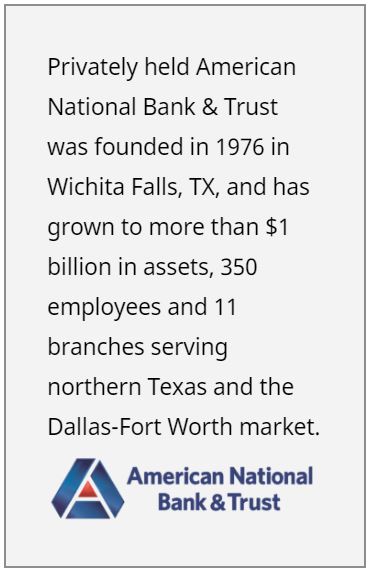 Roy Olsen of American National Bank & Trust is very clear about one benefit of serving on the executive team for a small financial institution: “I can act quickly when I see a need across the enterprise.”
Roy Olsen of American National Bank & Trust is very clear about one benefit of serving on the executive team for a small financial institution: “I can act quickly when I see a need across the enterprise.”
Olsen explained, “We didn’t believe we had a full picture of fraud – including both successful and attempted fraud. For example, I realized that if someone tries to pass a bad check at one of our branches, the other branches won’t know about it unless it results in a loss to the bank.”
The above scenario helps illustrate one of the many reasons American National Bank & Trust began using the FraudClassifierSM model. “It’s a way for us to collectively gather information and get everyone on the same page to better understand what’s happening with fraud,” Olsen said.
 As executive vice president, Olsen manages operations and human resources for his community bank. His responsibilities include managing fraud, as well as identifying and implementing efficiencies that benefit both employees and customers.
As executive vice president, Olsen manages operations and human resources for his community bank. His responsibilities include managing fraud, as well as identifying and implementing efficiencies that benefit both employees and customers.
Last year, he collaborated with other fraud experts from across the payments industry as a member of the Fraud Definitions Work Group to develop the FraudClassifier model. With the model taking shape, Olsen recognized it could fill an immediate need within his organization. As a result, he quickly secured his board’s approval to implement an early version of the model.
“Following the FraudClassifier model’s intuitive approach to classifying fraud, we kept implementation simple,” Olsen said. “We created a spreadsheet tool to track the model’s fraud classifications along with key elements of each incident, such as date, payment type, payment originator, amount, and if it resulted in a loss to the bank.”
Olsen said, “Our team immediately told us how easy the model is to use. In addition, everyone is answering the questions in the same way, so we get consistent fraud classifications for similar events across all our branches. This consistency helps pinpoint fraud trends affecting us and our customers.”
For Olsen and his team, these insights are then used to educate the entire organization about varying fraud types and trends. For example, business email compromise was trending higher in the early part of this year. This insight helped facilitate customer education on these types of scams through one-on-one interactions and statement stuffers.
“Our employees now ask customers additional questions when something sounds suspicious,” Olsen said. “By doing so, we often can determine there has been a fraud attempt before it becomes a loss to the bank or our customers.” To promote a risk prevention mindset, individual team members are recognized for thwarting fraud attempts. This further motivates Olsen’s team to stay vigilant about potential fraud attempts reported by customers.
At American National Bank & Trust, employees use the model by answering a series of questions to classify fraud involving payments. The model is built to be flexible, allowing classification additions or modifications as new information becomes available. However, Olsen said his team found the model to be extremely comprehensive, and that most of the initial classifications hold true even after obtaining additional information during the recovery process.
Olsen is confident the FraudClassifier model has demonstrated its value at American National Bank & Trust. “Since using the model, we have stopped 75 percent of our fraud attempts, simply because our staff members are more aware of fraud trends we identified by using the model.”
Olsen went on to share his encouragement for other financial institutions to consider leveraging the FraudClassifier model to better understand current and emerging fraud trends – especially during the current COVID-19 pandemic, as fraud attempts involving payments appear to be on the rise.
“The beauty of the FraudClassifier model is that it is both easy to use and provides valuable fraud information, regardless of the size of your financial institution.”
Sharing and use of the FraudClassifier model throughout the industry is encouraged; any adoption of the FraudClassifier model is voluntary at the discretion of each individual entity. The FraudClassifier model is not intended to result in mandates or regulations, and does not give any legal status, rights or responsibilities, nor is the FraudClassifier model intended to define or imply liabilities for fraud loss or create legal definitions, regulatory or reporting requirements. Absent written consent, the FraudClassifier model may not be used in a manner that suggests the Federal Reserve endorses a third-party product or service.
